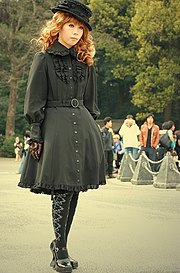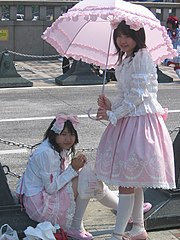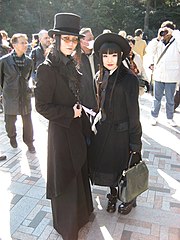Lolita fashion
From Wikipedia, the free encyclopedia
Lolita Fashion (ロリータ・ファッション Rorīta fasshon) is a fashion subculture in Japan that is primarily influenced by Victorian children's clothing as well as costumes from the Rococo period. Lolita has made this into a unique fashion by adding gothic and original design elements to the look. From this, Lolita fashion has evolved into several different sub styles and has created a devoted subculture in Japan. The Lolita look consists primarily of a knee length skirt or dress, headdress, blouse, petticoat, knee high socks or stockings and rocking horse or high heel/platform shoes.[1]
Although the origin of Lolita fashion is unclear, it is likely the movement started in the late 1970s when famous labels including Pink House, Milk and Angelic Pretty began selling clothes that would be considered "Lolita" by today's standards. Shortly after that came Baby, The Stars Shine Bright, and Metamorphose temps de fille. In the 1990s, Lolita fashion became better recognised, with bands like Malice Mizer and other Visual Kei (or visual type) bands coming into popularity. These bands wore intricate costumes, which fans began adopting as their own style.[2] The style soon spread from its origins in the Kansai region, and ultimately reached Tokyo where it became popularized throughout Japanese youth culture. Today, Lolita fashion has grown so much in popularity that it can be found even in department stores in Japan. Today many young people wear the fashion all around the world.
Contents |
[edit] Style types
[edit] Gothic Lolita
Gothic Lolita (known in Japan as gosurori, "goth-loli") is a mixture of the Gothic and Lolita fashion. The origins of the Japanese Gothic style can be traced back to the English New Wave Movement during the 1980s: however, the Japanese Gothic scene is fundamentally different from the Gothic subcultures of the west.[3] This Gothic fashion has been adopted into the Lolita fashion through the use of darker make up, clothing, and themes in the design. Unlike other Lolita Styles, in Gothic Lolita darker colors are used for makeup. Red lipstick and smoky or neatly defined eyes, created using black eyeliner, are typical styles.[4] The Gothic Lolita makeup is not as heavy or dramatic as the Western gothic counterparts. Newer makeup styles emphasize lighter colors but still retain the heavy eye makeup.[5]
The outfits themselves usually use dark color schemes like black, dark blues and purples. As with western gothic subculture, cross jewelry and other religious symbols are also used to accessorize the gothic Lolita look. Other accessories, like bags and purses, are often in uncommon shapes like bats, coffins, and crucifixes. [6]
Like many other Lolita fashions, the Japanese visual kei movement was responsible for helping to introduce and popularize the Gothic Lolita style. One artist in particular, Mana, a Japanese musician and fashion-designer, is considered to be the major force behind the popularization of the Gothic Lolita style, though he is not credited with creating it. Mana’s own Gothic Lolita fashion label, Moi-même-Moitié, has grown to be very successful. To describe the designs of his new label, he coined the terms Elegant Gothic Lolita (EGL) and Elegant Gothic Aristocrat (EGA) .[7]
[edit] Sweet Lolita
Sweet Lolita (amaloli) is heavily influenced by Rococo styles as well as Victorian and Edwardian children's clothing. Focusing on the child and fantasy aspects of Lolita, the Sweet Lolita style adopts the basic Lolita format and uses lighter colors and child fantasy themes in its design.
Makeup used in sweet Lolita is common throughout most Lolita styles. A natural look is emphasized, to help maintain the child like feel of Lolita. Light pastels, light pink, and natural colors make up the Lolita makeup color scheme.[8]
Sweet Lolita fashion places its focus on the child-like aspects of Lolita design. Outfits consist of pastels, gingham or other colorful prints, lace, bows, and ribbons to emphasize the cuteness in the design. Popular themes in the sweet Lolita are references to Alice in Wonderland, fruit, and cakes.[9] To keep with the child feel of sweet Lolita, the shoes usually have a smaller heel than that of other Lolita styles.
Jewelry often reflects this fantasy theme: Popular motifs include cherries, cakes, hearts, ribbons, and bows. Headdresses and bows are also a popular hair accessory to the sweet Lolita look. Bags and purses are often in the shape of stuffed animals or hearts. [10]
Momoko, a protagonist in the book/film Shimotsuma Monogatari (Kamikaze Girls in the US), is a popular example of sweet Lolita. She idealizes the rococo period and tries to "live" in the Rococo lifestyle through Lolita. She loves the popular Sweet Lolita brand called Baby, The Stars Shine Bright. Other Lolita brands include Manifesteange Metamorphose temps de fille and Angelic Pretty. Emily Temple cute (sister brand of Shirley Temple, a Japanese boutique for little girls), Jane Marple, and MILK are milder ama-loli (Sweet Lolita), and one can buy them at department stores in Japan.[11]
[edit] Classic Lolita
Classical Lolita is a more mature style of Lolita that focuses on Baroque and Rocaille styles. This look can be seen as the more sophisticated, mature Lolita style because of its use of small, intricate patterns, as well more muted colors on the fabric and in the overall design. The colors in the classic Lolita style are lighter than those in the gothic Lolita, but are not as light as those used in sweet Lolita .[12] Empire waist dresses are also used to add to the more mature look of the classic Lolita. Shoes and accessories are less whimsical and more functional. Jewelry with intricate designs is also common. The makeup used in classic Lolita is often a more muted version of the sweet Lolita makeup, with an emphasis placed on natural coloring. This Lolita style uses slimmer dress silhouettes than its counterparts to add to the mature style. An example of the classical Lolita brands are Juliette et Justine, Innocent World, Victorian Maiden and Mary Magdalene.
[edit] Punk Lolita
Punk Lolita (or Lolita Punk) adds punk fashion elements to Lolita fashion. Motifs that are usually found in punk clothing, such as tattered fabric, ties, safety pins and chains, screen-printed fabrics, plaids, and short, androgynous hairstyles are incorporated into the Lolita look. The most popular garments are blouses or cutsews and skirts, although dresses and jumper skirts are also worn. Common footwear includes boots, Mary Janes or oxfords with platforms. [13] Common Punk Lolita brands are A+Lidel, Putumayo, h. NAOTO and Na+H. Many of the Japanese punk Lolita fashion brands take influence from London's famous Camden Town Markets. Vivienne Westwood, who, though not a Lolita designer, has items and collections that reflect Lolita sensibilities, especially in her Japanese collections, is popular in the punk Lolita scene.
[edit] Other styles and themes
Because of the do it yourself nature of Lolita fashion, many other subtypes have come out of the basic Lolita frame. These styles are often not as well known as the ones mentioned above, but they do showcase the creative nature of the Lolita fashion, and illustrate how people make the fashion their own.[14] Listed below are just a few examples of the smaller subtypes of Lolita fashion.
[edit] Wa Lolita
Wa Lolita (or Waloli) combines traditional Japanese clothing styles with the Lolita fashion. Wa Lolita usually consists of kimono or hakama modified to fit with common Lolita garments. The bottom half of the garment is altered to accommodate a petticoat, or a kimono-style blouse is used as a top to accompany a plain Lolita skirt. Outerwear can include haori or adult-sized hifu-vests. The shoes and accessories used in this style are typical of traditional Japanese garb including kanzashi flowers, and geta, zori, or Okobo. These shoes are often used in place of the normal Lolita platform and high-heeled shoes.
[edit] Qi Lolita
Qi Lolita is a similar style but uses Chinese clothing and accessories in place of Japanese. Usually this includes qipao and cheongsam-dresses modified to accommodate a petticoat. Accessories include platform-slippers for footwear and bun-covers as hair accessories.[citation needed]
[edit] Ōji/kodona/dandy (male Lolita fashions)
Ōji (王子 ) or Ōji-sama (王子様 ), meaning "prince," is a Japanese fashion that is considered the male version of Lolita fashion. This style takes its influence from the clothing boys in the Victorian era wore.[15]
Ōji is inspired by what was worn by Victorian boys, but can be worn by either gender and includes masculine blouses and shirts, knickerbockers and other styles of short trousers, knee high socks, top hats, and newsboy caps. The colors usually used are black, white, blue and burgundy, though there are feminine versions of the fashion with a broader palette. Make-up, when worn with the fashion, is usually light and minimal, though sometimes when women wear it, more make-up is used than what they would wear with Lolita. Ryūtarō from Plastic Tree and Yukke from MUCC are two of the most popular wearers of the ōuji-sama style.
The term kodona (from "kodomo otona," literally "child-adult") was coined by Plastic Tree's vocalist Ryūtarō Arimura as he described his dress sense and is often used as the Western name for the fashion.
[edit] Hime Lolita
Hime, or "Princess," Lolita is characterized by a princess-style look based upon the European aristocratic style.[16][17]
[edit] "Lolita"
Although "Lolita" is a reference to Vladimir Nabokov's famous novel, and lolita fashion is often worn by teens, most followers of the style do not consider it overtly sexual. Adherents present themselves as Victorian children or baby dolls and prefer to look "cute" rather than "sexy." Many Lolitas claim that the term 'Lolita' doesn't necessarily have anything to do with sex at all. The usage of the word may also be considered wasei-eigo. Japanese culture places a higher value upon extremely youthful appearance and behavior than Western, and some adult women buy large amounts of products, such as Hello Kitty goods, that are typically marketed only to children in the West. SweetLoli is perhaps a more visible extension of this phenomenon. [18]
[edit] Influence and popularity
Lolita was influenced and popularized by the imagery of more feminine Visual Kei (or "visual art") bands. Visual Kei is a Japanese form of rock music defined by bands featuring performers in elaborate costumes but whose musical style varies. Mana, the cross dressing former leader and guitarist of the Visual Kei band Malice Mizer is widely credited for having helped popularize Gothic Lolita. He coined the terms "Elegant Gothic Lolita" (EGL) and "Elegant Gothic Aristocrat" (EGA) to describe the style of his own fashion label Moi-même-Moitié, which was founded in 1999 and quickly established itself as one of the most coveted brands of the Lolita scene. [19]
[edit] In popular culture, anime, and manga
| This section may contain original research or unverified claims. Please improve the article by adding references. See the talk page for details. (December 2008) |
Due to the popularity of this cute style with many fans of Japanese animation and comics, characters dressed in the "lolita" style may be found in numerous anime and manga. Some of the most prominent are Negima,Paradise Kiss, Le Portrait de Petit Cossette, Pandora Hearts, Tsukuyomi -Moon Phase-, Othello, xxxHolic, Tsubasa: Reservoir Chronicle (Infinity Arc), Princess Princess, Godchild, Death Note, Chobits, Rozen Maiden and Dazzle (manga). However, large numbers of lolita girls are visible at anime/manga events such as Comiket. Cosplaying these fashions is usually looked down upon by the EGL community, since Lolita is considered to be a lifestyle rather than a costume.
[edit] Lolita culture
In Japan, despite still being a subculture and fringe fashion, Lolita fashion is mass-marketed and has wide visibility particularly in the streets of Tokyo and Osaka, on television, in manga (see Paradise Kiss by Ai Yazawa for an example of lolita inspired manga) and computer games. Outside of Japan it is still a widely unknown fringe fashion although it has slowly begun to spread to other countries. Lolita fashion, along with cosplay and other Japanese cultural phenomena, can sometimes be seen at concerts and anime conventions throughout Europe and the United States. The style has not yet been mass marketed outside of Japan, although increasingly Japanese brands are available for purchase abroad directly from the brands. However, there are plenty of dedicated fans filling the still-remaining gap. Lolita fashion magazines are widely available for purchase on the Internet and at Japanese bookstores which also deal in anime and manga. Adherents often sew their own homemade lolita outfits, sometimes offering them for sale to make up for the difficulty of acquiring them from Japan. Apart from most western fashions, Lolita tends to hold higher expectations to those that dress it. Higher quality clothes are favored over "cheap" lace and cosplay-esque designs. [20] Many adherents also purchase lolita outfits and accessories online from Japanese brands such as Baby, The Stars Shine Bright or other fellow lolitas.
[edit] Gothic & Lolita Bible
One magazine in particular, the seasonally published Gothic & Lolita Bible, has played an instrumental role in promoting and standardizing the style. The 100+ page magazine includes fashion tips, photos, sewing patterns, catalog descriptions, decorating ideas, and recipes. Tokyopop has been releasing the English language version of the magazine since February 2008. [21]
[edit] See also
[edit] References
- ^ Ishikawa, Katsuhiko, Gothic & Lolita, Phaidon, 2007, pp 13, 89, 93 Et al
- ^ Ishikawa, Katsuhiko, Gothic & Lolita, Phaidon, 2007, p 1
- ^ Ishikawa, Katsuhiko, Gothic & Lolita, Phaidon, 2007, p2
- ^ Anonymous, “Gothic Lolita Hair and Make Up”, Gothic & Lolita Bible, vol 4, Nuuberuguu, 2002, pg 79
- ^ Anonymous, “Neo Gothic Style”, Gothic & Lolita Bible, vol 4, Nuuberuguu, 2002, pg 81
- ^ Anonymous, “Gothic and Lolita: New Style”, Gothic & Lolita Bible, vol 4, Nuuberuguu, 2002, p102
- ^ Anonymous, “Artist Brands: Part 1, Mana x Moi-mene-Moitie”, Gothic & Lolita Bible, vol 4, Nuuberguu, 2002, pg 23
- ^ Anonymous, “Classic Lolita Style”, Gothic & Lolita Bible, vol 4, Nuuberuguu, 2002, pg 78
- ^ “IMF's ‘Local Feed’ Tokyo - Lolita Fashion” July 03, 2007 http://www.youtube.com/watch?v=daUWU2C9yFo
- ^ “IMF's ‘Local Feed’ Tokyo - Lolita Fashion” July 03, 2007 http://www.youtube.com/watch?v=daUWU2C9yFo
- ^ Takemoto, Novala, Kamikaze Girls, Viz Media, San Francisco, CA, February 14, 2006. and ロリータ・ファッション
- ^ Anonymous, “Neo Lolita Style”, Gothic & Lolita Bible, vol 4, Nuuberuguu, 2002, pg 80
- ^ “IMF's ‘Local Feed’ Tokyo - Lolita Fashion” July 03, 2007 http://www.youtube.com/watch?v=daUWU2C9yFo
- ^ Saramaki, Rinna, “From Boring to Beautiful”, La Vie en Rose, vol 2, pg 21-24 .
- ^ Seagrave, Amber, "Style: Kodona," La Vie en rose, vol.2, p.18
- ^ http://www.lolitafashion.org/hime_lolita.php
- ^ http://online.wsj.com/article/SB122713804938242481.html
- ^ Japanese Lifestyle. May 21, 2005. Japanese Lifestyle, Gothic Lolita. http://www.japaneselifestyle.com.au/fashion/gothic_lolita.html
- ^ Japanese Lifestyle. May 21, 2005. Japanese Lifestyle, Gothic Lolita. http://www.japaneselifestyle.com.au/fashion/gothic_lolita.html
- ^ Japanese Lifestyle. May 21, 2005. Japanese Lifestyle, Gothic Lolita. http://www.japaneselifestyle.com.au/fashion/gothic_lolita.html
- ^ Tokyopop to Ship Gothic & Lolita Bible in February. December 4, 2007. Anime News Network. http://www.animenewsnetwork.com/news/2007-12-04/tokyopop-to-ship-gothic-and-lolita-bible-in-february
[edit] External links
| Wikimedia Commons has media related to: Lolita fashion |
- Lolita Gallery
- Lolita Fashion.org informative website and community forums
- Lolita Handbook - Guide to Lolita fashion on Livejournal
- Avant Gauche - Lolita Shop Reference and Image Galleries
- Loli-Pop: A Downtown Auckland View on Japanese South Fashion
- Video Tour of Harajuku Fashion
|
||||||||





